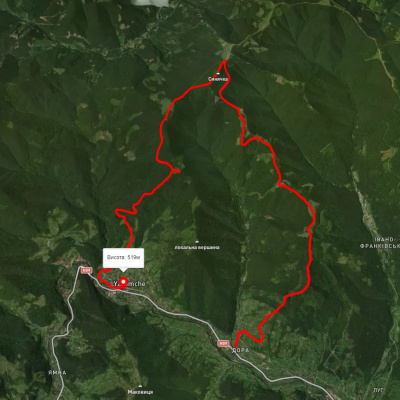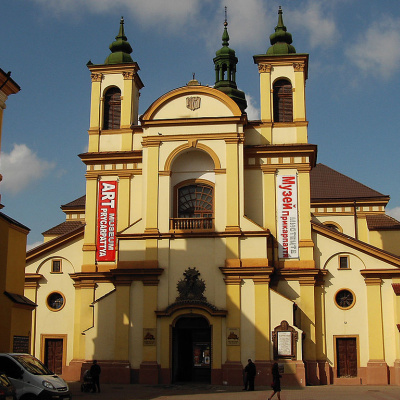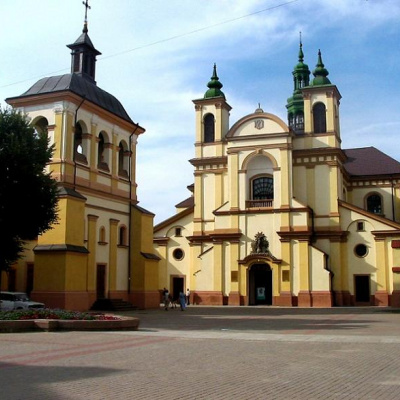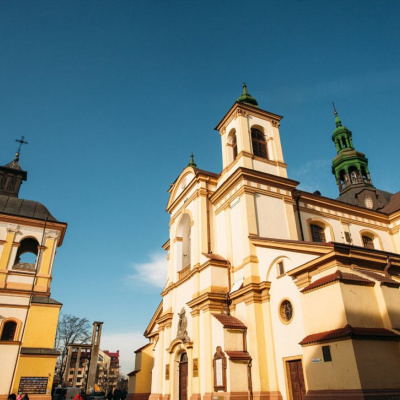Ivano-Frankivsk Regional Art Museum
TheMuseum of Arts of Prykarpattia (from 1980 to 2012 - Ivano-Frankivsk Regional Art Museum) is a regional art museum in Ivano-Frankivsk; a treasure trove of sacred, fine and decorative art of the region. The museum possesses one of the best collections of Galician sacred art, including works by the outstanding Baroque sculptor Johann Georg Pinsel.
The activities of the only museum of artistic profile in the region are aimed at professional study and popularization of the work of artists of the Carpathian region, search for works of ancient art and their scientific study and preservation.
On May 18, 2020, the Ivano-Frankivsk Art Museum celebrated its 40th anniversary in the premises of the city's oldest architectural monument, the former church and tomb of the Potocki family (1672-1703). During its existence, the museum has amassed a fifteen-thousand-piece collection of artworks: Galician iconography of the XV-XIX centuries, baroque sculpture of the region, a unique collection of paintings by Italian, Austrian, and Polish artists, ancient church clothes and books, and various folk art products. Particularly noteworthy are the exhibition "Sacred Art of Galicia in the XV-XX centuries" and the exhibition of Baroque sculpture by Johann Georg Pinsel, which harmoniously fits under the arches of the church.
The exhibition of the sacred art of Galicia of the XV-XX centuries of the Ivano-Frankivsk Art Museum, which opened on August 18, 1993, became an original phenomenon of national museum practice. It became one of the cultural phenomena of the region.
The collection of works of art, including sacred art, in the region was marked by tragic inconsistency.
Rarities were always exported from here. Only the National Museum in Lviv and the National Art Museum of Ukraine in Kyiv have several hundred works of art from the fifteenth and sixteenth centuries, including such basic monuments for the study of Ukrainian art as icons of the 16th century. by the monastery master Dmytro from Dolyna, mid-16th-century "feast days" from Kalush, monumental "Passion of Christ" of the late 16th and early 17th centuries from Bilyi Oslav in Nadvirna region, fragments of the iconostasis of the Church of the Great Martyr Paraskeva (1718) in Hutsul region, and the Bohorodchany iconostasis (1698-1705) by Job Kondzelevych from the Maniavskyi Skete. This is not a case of "robbery" of the Carpathian region, because these works could have disappeared without a trace. In the absence of museum centers and associates of the level of Metropolitan A. Sheptytsky, I. Sventsitsky, or M. Bilyashivsky, the founders of Ukrainian museums, the local artistic and historical landscape was rapidly being exposed during the nineteenth and twentieth centuries.
In 1928, the Pokutsk Museum was founded in Stanislaviv (after 1962 - Ivano-Frankivsk), focused mainly on collecting Polish cultural heritage. Its first exhibition, which included royal privileges, historical documents of the magistrate, maps and plans of the city, manuscripts of the XV-XVIII centuries, portraits, religious paintings, baroque sculpture, and church vestments, was exhibited in the settlement hall of the savings bank (now Mazepa Street, 14). In 1939, after the annexation of western Ukrainian lands, the museum's collections were merged with a private ethnographic collection in Zhab'yem (Verkhovyna) to create the regional museum of history and local lore. In the postwar period, methodical actions were taken to destroy "ideologically harmful" works of art. A collection of European paintings and graphics collected by people from Stanislaviv in Vienna, Paris, and Krakow was destroyed. More than thirty icons painted on glass, which Olena Kulchytska had seen and described in 1952, are smashed to pieces. Wooden crosses are burned and Hutsul ceramics with Christian symbols are destroyed. The collection of ancient weapons and works of decorative and applied art is taken out of the city and Ukraine. Instead, the Kolomyia Museum of Folk Art of the Hutsul and Pokuttya regions managed to save unique church antiquities collected by its founder, V. Kobrynsky, which were simply walled up in one of the museum rooms.
The collection of sacred art of the Ivano-Frankivsk Art Museum, founded in 1980, is not only one of the largest in the region (it includes nine hundred works of the main fund), but also extremely diverse in composition. It includes monuments of iconography of the fifteenth and early twentieth centuries, baroque sculpture, folk carvings, old prints, and works of liturgical and ceremonial purpose.
It was formed almost immediately after the "iconoclastic" measures of the Soviet government, which swept through Galicia in two destructive stages. Immediately after 1946, the interiors of churches were smashed and sculptures were removed from Greek Catholic churches that had been converted to Russian Orthodoxy, and from the early 1960s until the anniversary celebrations of the 1000th anniversary of the baptism of Kievan Rus in 1988, closed churches were massively "re-profiled" and "developed" as "folk" museums, clubs, warehouses, and funeral homes.
During 1983-1987, museum staff examined church property dumps in the closed churches of Zaluzhzhia, Pukiv (Rohatyn district), Zavadky, and Bolokhiv (Kalush district). Sloboda Rivnianska (Rozhnyativ district), Pidlisok (Dolyna district), and Chekhova (Horodenkiv district). The first significant acquisition of works of sacred art to the museum's storage facilities was associated with the transfer of half-destroyed sculptures (about 100 pieces) from the basements of the Ivano-Frankivsk Cathedral, where they were brought by order of the Committee for Religious Affairs and under the supervision of the KGB since the 1950s. These were mostly folk sculptures of roadside chapels and crosses, as well as figurative plastic that was removed from Greek Catholic churches that had been converted to Orthodoxy. Among the transferred works, the Baroque sculptures of the Apostles Peter and Paul and the Adoring Angels from the main altar of the church in Halych (ca. 1782), attributed to the outstanding master Jan Obrotskyi, were later discovered and exhibited after restoration. In 1985-1986, more than 200 figures and fragments of decorative altar carvings of the Colegiate Church were transferred from the Krylos Historical and Architectural Reserve (St. Basil's Chapel, the attic of the Assumption Church, and the Church of St. Panteleimon in Shevchenkove), which were taken there after the destruction of its interior in 1962 to be used as a mineralogy museum. Earlier, some of this unaccounted for sculpture was in the collection of the Lviv Art Gallery in Olesko Castle, and is also in the functioning Roman Catholic Church of Christ the King in Ivano-Frankivsk. Thanks to specially organized trips in 1987-1988, the remains of an abandoned sculpture by Johann Georg Pinsel in the Missionaries' Church in Horodenka were rescued (most of the badly damaged sculptures were taken out by B. Voznytskyi in 1960). Voznytskyi in the 1960s to the Lviv Art Gallery; now they are in the Pinsel Museum in the Clarissa Church in Lviv) and an interesting complex of altar sculptures from the Bernardine Monastery in Hvizdka, In August 1983, the exposition department of the Ivano-Frankivsk Art Museum was opened in the wooden church of the Holy Spirit (1598) in Rohatyn. Along with the unique early Baroque iconostasis of 1650, it presents rare icons of the XVI-XVIII centuries. Icon-painting of this region is represented in the exposition of sacred art by such primary icons as the painted silhouette "Crucifixion" and "The Virgin with the Prophets" of the XVI century, "Feast days", "Annunciation" and "Baptism" from Voynyliv district, "Exaltation of the Holy Cross", "Saviour Pantocrator" from the first half of the seventeenth century from Rohatyn district, etc. Among the found rarities is a fragment of a mid-15th-century Gothic altar with the image of St. Margaret, which was donated in 1940 by Polish engineer Pawel Setkowicz to the church in the village of Ripne in Rozhniatyn district as a family heirloom.
The works rescued during museum expeditions were restored in 1980-1990 at the Lviv branch of the State Research Restoration Workshops (now the National Research Restoration Center Lviv Branch) and partially at the Restoration Department of the Kyiv State Art Institute (now the National Academy of Arts and Architecture in Kyiv). In 1993, the first exhibition version of the development of sacred art of the XV-XX centuries in the territory of modern Ivano-Frankivsk region was created from fragments of the once powerful artistic pose, which is supplemented and clarified by new materials to this day.
Thus, by chance, the exposition is deployed under the middle cross of the former collegiate church of the Immaculate Conception of the Virgin Mary, Saints Andrew and Stanislav (1672-1703). The iconography of the XV-XIX centuries is presented in two side naves, the chamber space of which resembles the scale of small wooden churches in the Boikivshchyna, Hutsulshchyna, and Pokuttya, where most of the iconographic works originated. The area under the church's central cross is filled with Baroque sculpture of the 18th century. The exposition, which envelops the interior around the perimeter, ends in the eastern nave with monuments of folk iconography and carving of the XVIII-XIX centuries.
Its maximally tolerant relationship with the church extends to the much deeper context of the historical urban environment, its buildings, sacred architectural monuments, builders and artists of our city. Together they form a distinctive macrocosm of Ivano-Frankivsk's artistic and historical memory, which is gaining a new quality in the process of further development and restoration of the city center. The museum and its sacred exposition are a bridge between the past and the future, a meeting place for various artistic, national, cultural, and spiritual traditions that deserve attention and respect.
The Museum of Art of Prykarpattia is located in the premises of a former church, which is a historical and architectural monument of national importance, in the heart of Ivano-Frankivsk at 8 Sheptytskoho Square, Ivano-Frankivsk, 76000.
The institution is open to visitors every day, except for the weekend (Monday) from 10:00 to 17:00.
Accommodation around Ivano-Frankivsk Regional Art Museum:
Які маршрути проходять повз Ivano-Frankivsk Regional Art Museum?
Пропонуємо пройти такі туристичні (пішохідні) маршрути через/біля Ivano-Frankivsk Regional Art Museum: с. Пасічна, через с. Манява, Манявський вдсп., г. Велика Сивуля до с. Бистриця, с. Манява - пол. Монастирецька, с. Дора, через г. Синячка, пер. Пересліп, пол. Туршугувата, хр. Явірник до м. Яремче, с. Дора, через г. Синячка, пер. Пересліп до м. Яремче, с. Дора, через г. Синячка, пол. Чорногориця до м. Яремче, с. Дора, через г. Синячка, хр. Чорногориця до м. Яремче
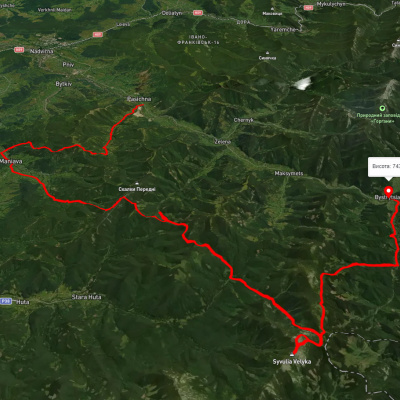
с. Пасічна, через с. Манява, Манявський вдсп., г. Велика Сивуля до с. Бистриця
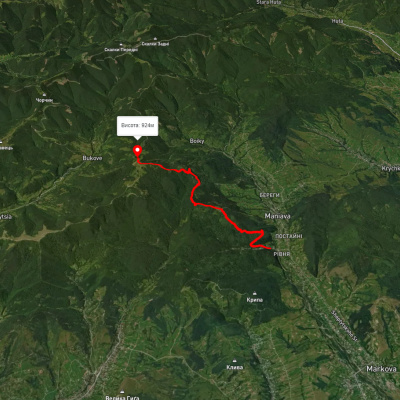
с. Манява - пол. Монастирецька
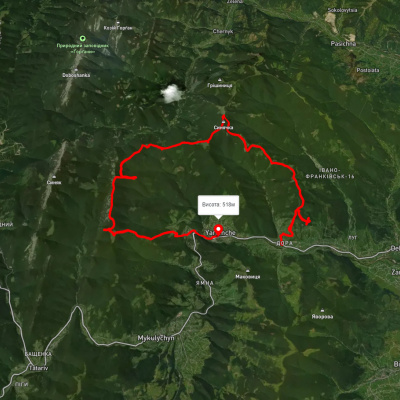
с. Дора, через г. Синячка, пер. Пересліп, пол. Туршугувата, хр. Явірник до м. Яремче

с. Дора, через г. Синячка, пер. Пересліп до м. Яремче
